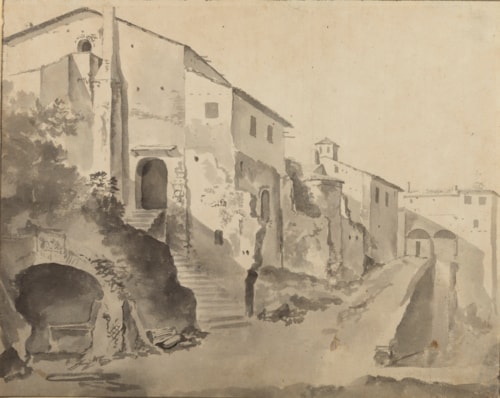
Thomas WIJCK
Beverwijk 1616/21 - Haarlem 1677
Biography
Born in a town near Haarlem, Thomas Adriaensz. Wijck entered the artist’s guild there in 1642. He is thought to have been a pupil of Adriaen van Ostade in Haarlem and was based in the city for most of his career. Best known today for his painted, drawn and etched Italianate landscapes, Wijck also produced a number of paintings of the very different subject of alchemists in their workshops. Although there is no direct evidence that Wijck actually visited Italy, it can be inferred that he did so, both from the evidence of his drawings - some of which bear Italian watermarks - and the fact that he is unrecorded in Haarlem between 1644 and 1653, when he is likely to have travelled to Italy, although this may also have occurred between 1653 and 1656. (It has been suggested that he might have studied with Pieter van Laer in Rome.) What is certain is that Wijck visited England in the early 1660s, when he produced some views of London and its surroundings, and he seems to have remained there until shortly before his death in Haarlem in 1677. Wijck’s son Jan was also an artist, and later settled in London.
Wijck was a prolific draughtsman, producing mainly landscape studies, street scenes, courtyards and farmyard subjects, as well as a handful of studies of empty kitchen or workshop interiors. His earliest dated drawings are from 1643 and 1645, and several of his Italianate drawings have previously borne attributions to the slightly older landscape painter and draughtsman Jan Asselijn (c.1610-1652), whose Roman drawings, together with their choice of subjects, seem to have been a particular influence on his own. A number of drawings by Thomas Wijck are today in the Rijksmuseum in Amsterdam, while other examples are in the Kupferstichkabinett in Berlin, the Musée des Beaux-Arts et d’Archéologie in Besançon, the Statens Museum for Kunst in Copenhagen, the National Galleries of Scotland in Edinburgh, the Teylers Museum in Haarlem, the British Museum in London, the Puskhin Museum in Moscow, the Yale Center for British Art in New Haven, the Metropolitan Museum of Art and the Pierpont Morgan Library in New York, the Nasjonalgalleriet in Oslo, the Louvre and the Fondation Custodia in Paris, the Boijmans-van Beuningen Museum in Rotterdam, the State Hermitage Museum in St. Petersburg, the Staatliche Kunstsammlungen in Weimar, the Albertina in Vienna, and elsewhere.


